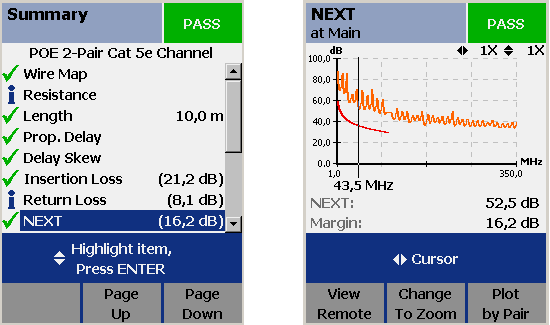Explanations concerning measuring devices
Practice-orientated hints on the specific use of cable measuring devices are given below.
 | Changing the settings A product from a third party manufacturer is described in the following chapter. The respective operating manual is to be given priority. The data given below for the measuring device settings were valid at the time of preparing this documentation – it is possible, however, that the manufacturer of the measuring device may have changed the firmware/program user interface at short notice. The notes below should be considered to be supplementary to the manufacturer’s own operating manual. |
Fluke DTX1800
Device tested: Fluke DTX1800, year of manufacture 2008, software 2.1200, hardware 12, DTX limits 1.3400.
The following settings need to be made on this cable certifier before the test commences:
- Adaptor: hardware with which the cable to be measured can be connected to the measuring device: permanent link, channel and patch adaptor.
- Cable limit value: limit value data records are available for various standards (ISO, TIA, China etc.) and connections (channel, permanent link, patch etc.).
Such a limit value record (‘Limits’) consists of equations that are stored in the test device for various measurements (return loss, NEXT, ACR etc.) according to frequency (1 – 100 MHz for Class D) as per EN50173. - Cable type: 2 or 4 pairs, NVP
- Connector Pin Assignment: TIA568A/B, 2pair, POE etc.
In EtherCAT applications, a normal test object (CuT – Cable under Test) can be accepted as follows:
- Ethernet cable section 0.5 – 100 m
- Max. 6 connectors in between or max. 3 double couplers
- Shielded 4-core cable as per EN50288-2
- RJ45 plug at both ends
- Core assignment 1,2,3,6+ screen as per TIA-568B
- Arbitrary mixture of rigid and permanently installed cables (observe design notes)
The following settings have proven to be standard-compliant and usable for the certification of a (possibly field-configured) Ethernet-EtherCAT cable section:
- Adaptor: channel adaptor DTX-CHA001A
Reason: unlike the patch cable adaptor, the screen continuity can be tested with the CHA001A. Since Nov 2008, according to Fluke, the connector compensation provided for in the channel measurement only takes place if the end plugs meet the electrical requirements for the performance class. Therefore, permanent link adaptors and double couplers need not be used. - Cable limit values: ‘POE 2 pair Cat5e Channel’
Reason: the cable limit values according to EN50173-1 Channel Class D and a 2-pair assignment are required. This combination is possible in the DTX1800 via this limit value record. The specified limit value record corresponds in its data in all relevant frequency ranges to ‘EN50173, Channel Class D’, but allows reduced cable assignment according to 1-2-3-6.
The limit value record (DTX limits) 1.34 from the Nov 2008 is used. - Cable
- for the Beckhoff ZB90x0 cables, a ‘user-defined’ cable must be created with
# 2 pairs/4 cores
# NVP = 62% (according to cable supplier’s data)
- if necessary, select a 4-pair/8-core cable from the manufacturer’s database - Connector Pin Assignment
- ‘Ethernet 2 pair’ (already defined in the database) or user-defined ‘TIA568B’ without contacts 4-5 and 7-8.
- or normal TIA568B pin assignment for fully assigned cable
 Fig.36: Fluke DTX1800 screenshots
Fig.36: Fluke DTX1800 screenshots  | Detection of interference In the operating mode ‘Monitor’, the DTX1800 can detect interspersed interference on the transmission link. To do this, the link must be taken out of operation and a test device connected at both ends. |